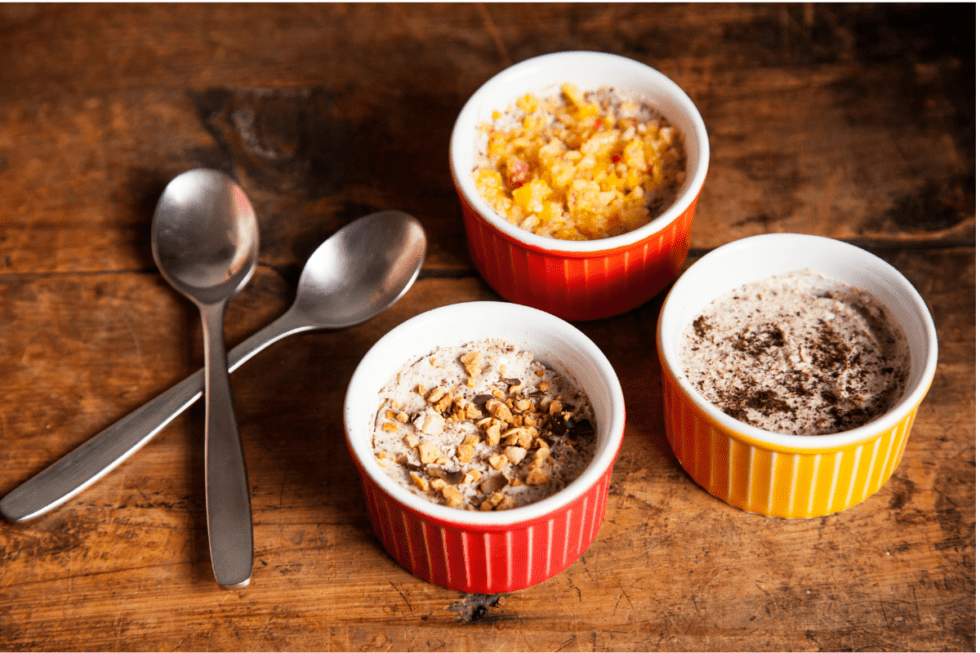
Low Histamine Baruka Nut Vanilla Mousse Recipe (Medium Oxalate, Low Lectin, Low FODMAP, Low Salicylate option)
You might think eating a low histamine diet means that sweets like vanilla mousse are off the menu.
But you can still indulge in a decadent dessert with this easy to make recipe.
This smooth and silky treat will satisfy your sweet tooth. And it makes the end of any meal feel extra special.
I made this recipe over the holidays while I had some time off. I was craving sweets. And I wanted to try something new.
I love sharing my creations with you, so I hope you’ll enjoy this low histamine recipe.
Are you looking for a delicious end for a romantic dinner? Or do you need something easy to whip up during the week for the family? Either way, this recipe fits the bill.
This recipe is:
- Low Histamine
- Medium Oxalate
- Low Lectin
- Low Salicylate optional
- Low FODMAP
- Gluten Free
- Dairy Free
- Vegan
Normally, a dessert like this would be high histamine. But I’ve come up with some different ingredients to make a low histamine dessert suitable for your needs.
You’ll read about that next.
What to Skip in a Vanilla Mousse Recipe
Whether it’s chocolate mousse, vanilla mousse, or coconut mousse, I love the silkiness of this traditional French dessert.
Fun Fact: The French word mousse means “foam.”
And when you think of the light, fluffy texture of mousse, that’s certainly a fitting name.
Mousse is creamy, kind of like vanilla pudding. But it’s lighter and airier.
It has a melt-in-your-mouth quality that keeps you wanting bite after bite.
However, a traditional mousse recipe requires a lot of ingredients that are off the table if you are on the low histamine diet. Or if you have Mast Cell Activation Syndrome (MCAS).
You’ll read that list next. Then I’ll share some tips for choosing the best ingredients for this dessert.
But first, here’s a list of traditional mousse ingredients we limit or avoid on the low histamine diet. We won’t be using any of these.
Some of the following ingredients are technically not high histamine.
However, in Phase 1 of the low histamine diet, you may be avoiding some of these foods. That’s because they:
- Are common allergens
- May trigger immune sensitivities that make mast cells react and release histamine
- Spike blood sugar and cause histamine release
In this baruka nut vanilla mousse recipe, you won’t find any of these ingredients:
- Corn starch
- Gelatin (gelatin sheets or unflavored gelatin powder)
- Eggs (including both egg yolks and egg whites)
- Heavy whipping cream (or Cool Whip)
- Whole milk
- Granulated sugar
- Powdered sugar
- Butter
- Vanilla extract
Looking at that list, you may be wondering how we are going to make a tasty dessert without all those ingredients!
Here’s how.
Making a Low Histamine Baruka Nut Vanilla Mousse
A lot of the ingredients you see in the list above are typical mousse recipe ingredients.
Creating a dessert that gives you the same silky, creaminess of a mousse isn’t as easy as swapping out ingredient A for ingredient B.
It took some imagination to create a vanilla mousse dessert recipe for the low histamine dietary needs.
You don’t want something too thin and runny. And you don’t want something too thick either.
Additionally, you want it to be tasty and satisfy your sweet tooth!
Here are my tips for choosing the best ingredients.
Vanilla
For a baruka nut vanilla mousse, you want vanilla flavor.
Small amounts of vanilla extract are tolerated by some people.
For others, the alcohol in the extract can be a trigger. Most alcohol is high histamine.
Related Posts: But I have found lower histamine wine and made some low histamine cocktail recipes!
Some lesser quality vanilla extracts can have artificial colors, flavors, and preservatives. Those can be mast cell triggers, too.
I can tolerate many foods now. But I still prefer to get my vanilla flavor from raw vanilla powder. To me, the flavor is more natural.
Vanilla powder is made from dried vanilla beans (removed from the vanilla pod) which are then ground into a fine powder.
Look for vanilla powder that is made from vanilla pods. It should be dark brown in color. And there shouldn’t be any additional ingredients.
I use vanilla powder in a lot of my low histamine recipes like:
- Scones with Blueberry or Cream Topping – Low Lectin & Medium Oxalate
- Apple Crumble – Low Lectin & Low Oxalate
- Carrot Cake – Low Lectin & Medium Oxalate
I’m not the only one who likes vanilla powder, though. I’m seeing more articles showing that some cooks prefer vanilla powder for certain recipes.
And in some instances, tasters have noted that recipes using vanilla powder have a more natural and robust taste.
That may be because the alcohol in the vanilla extract cooks out to some degree in high heat. And it takes some vanilla flavor with it.
My favorite brand is Summer Day Naturals Vanilla Powder.

Summer Day Naturals Vanilla Powder
The vanilla they use is grown without pesticides, herbicides, or synthetic chemicals.
And if you are adapting an existing recipe, the substitution is easy. It’s 1:1.
That means if your recipe calls for 1 teaspoon of vanilla extract, you can use 1 teaspoon of vanilla powder instead.
Now, some people think that vanilla powder is more potent than vanilla extract. And they suggest using a little less.
You can experiment to see what you like best.
I hope this will help you when you adapt some of your own dessert recipes!
TIP: Write what your preference is for subbing it for vanilla extract on your bag to make it easy to reference.
As a bonus, vanilla also has some health benefits!
Health Benefits of Vanillin
Vanillin, a compound found in the vanilla bean, has been shown in studies to have:
- Anti-inflammatory properties
- Antioxidant properties
- Neuroprotective (brain health) benefits
You’ll also find nutrients like these in the vanilla bean:
- Magnesium
- Calcium
- Potassium
Vanilla isn’t so boring after all, is it?
Next let’s look at what makes this baruka nut vanilla mousse recipe creamy.
Coconut Cream
Most of the creamy goodness of this recipe comes from thick, rich coconut cream.
This replaces the dairy whipping cream and eggs that make up the base of many traditional mousse recipes.
TIP: This recipe is best if you refrigerate coconut cream for at least 8 hours. It will be easier to whip.
Coconut cream is a good source of saturated fats.
Saturated fats have been demonized, but they aren’t all bad. You just don’t want an overabundance of them.
But saturated fats are important for HDL (good cholesterol) levels.
And they are required for healthy brain cells.
Saturated fats are also important for hormone balance.
You can see why it is important to get some fat in your diet. Just don’t overdo it and be sure to balance with inflammation-resolving Omega-3s.
You can get Omega-3s from low-histamine seafood.
And for supplements, I like SPMs.
And you’ll get nutrients like vitamin C and iron from coconut, too.
Choosing Coconut Cream
Make sure your coconut cream doesn’t come in a can lined with BPA.
BPA is a chemical found in plastics that can act as an endocrine disruptor. That means it can affect your endocrine system or hormones.
Did you know that hormonal imbalances are one of the top root causes of MCAS?
This organic coconut cream from Let’s Do Organic has worked out very well for me.
It comes in a can, but the manufacturers have their cans third party tested. Tests show “no BPA detected”.

And whatever you choose, make sure you are getting a coconut cream that is just coconut cream (or even coconut cream with filtered water is ok.)
Choose one without any added sugars, artificial flavorings, or preservatives.
Baru Nuts (Baruka Nuts)
The other creamy element of this dessert is nut butter.
Specifically, baruka nut butter.
Have you tried baruka nuts yet? If not, you’re in for a treat.
Baruka (or baru) nuts are good as a snack on their own. Or you can add them to a homemade trail mix.
In this recipe, you’ll puree them into a smooth nut butter.
But did you know that baruka nuts aren’t nuts at all? They are the seeds from the fruit of the baru tree.
They are oval with pointy ends. They kind of look like small, skinny footballs. And they have a dark brown color like a coffee bean.
The flavor of a baru nut is sometimes described as being between a cashew and a peanut.
Baru nuts are low histamine, low lectin, and medium oxalate.
And they are a good source of:
- Plant-based protein
- Calcium
- Potassium
- Omega 3s
In this recipe, the baruka nut butter is going to add flavor and body to our baruka nut vanilla mousse. The consistency is like peanut butter.
When choosing baru nuts, or any nut, I recommend getting pesticide-free nuts to be on the safe side.

Low Histamine Sweeteners
Granulated sugar or even powdered sugar raises your blood sugar. Blood sugar imbalances can affect your histamine levels.
If you are working on reducing your histamine levels, you’ll want to consider other sweeteners instead.
I like stevia and monk fruit extract or monk fruit powder.
Here’s what you should know when choosing these ingredients.
Stevia
Stevia is a natural sweetener that comes from the stevia plant. It doesn’t affect blood sugar levels like cane sugar.
You can find stevia sweeteners with or without alcohol. Just like with vanilla extract, you may be able to handle it depending on your level of sensitivity.
And just like with vanilla extract, some of the lesser quality products have fillers.
When choosing one, make sure you don’t see anything except stevia leaf extract, water, and in some cases alcohol.
Some will have “natural flavors” which aren’t always very natural at all!
And some have other added preservatives and flavors. Just read the label carefully.
Or you can simply choose from one of these that I’ve already tried out.
This is the stevia I think tastes the best. It does have some alcohol content:

If you’re extra sensitive, you may want to use this alcohol free Stevia with glycerite.

And here is a stevia powder that doesn’t contain alcohol:

I’ve only tested this baruka nut vanilla mousse recipe with stevia drops. If you need to use the powder, you’ll need to experiment.
But remember, with both drops and powder, a little goes a long way!
1 teaspoon of stevia can add about as much sweetness to a recipe as an entire cup of white, granulated sugar.
So, go slow with the stevia. And remember, this recipe also calls for monk fruit powder which will also add sweetness.
Speaking of monk fruit powder, here’s what you should know.
Monk Fruit Powder
Monk fruit extract and monk fruit powder come from the monk fruit.
Monk fruit is a round fruit about the size of a lime. It’s native to southern China.
You may also see the fruit called luo han guo.
Monk fruit is sweet. And just like with stevia, the sweeteners made from the monk fruit don’t affect blood sugar levels like cane sugar.
But not all monk fruit powders and extracts are equal in terms of taste.
In fact, there is only 1 brand of monk fruit powder I’ve tried and liked. And I’ve tried many.
A lot of the ones I’ve sampled have an aftertaste like what you’d experience with a diet soda.
That’s why I only use Smart Monk Fruit Powder now.
I’ve even had Mast Cell 360 clients tell me they weren’t happy with other brands either.
It’s a noticeable difference in taste.
So go with Smart Monk Fruit Powder!

I hope you’ll enjoy this Baruka Nut Vanilla Mousse Recipe.
Baruka Nut Vanilla Mousse Toppings
It’s delicious on its own. But you can jazz it up with different toppings.
It makes an excellent base to get creative.
You can garnish this mousse recipe with toppings like:
- Lime zest (if tolerated)
- Fresh berries or other low-histamine fresh fruits
- Crushed nuts like baru nuts, macadamia nuts, or pecans
- Chopped herbs like mint
- Whipped coconut cream sweetened with stevia
(If you have Salicylate Intolerance, some of these options won’t be right for you. Check out the Low Salicylate Foods List for more ideas. And see below how to make this recipe low salicylate!)
Low Salicylate Vanilla Mousse
Here’s what you need to adapt to make this version:
- Sub sunflower seed butter or pecan butter for baruka nut butter (skip steps 1-3)
- Sub grass fed whipping cream, only if tolerated, for coconut cream
- Sub maple syrup to taste for stevia and monk fruit
- Leave out the powdered vanilla (You’ll still get plenty of flavor from the nut or seed butter)
This recipe is low FODMAP at one serving.
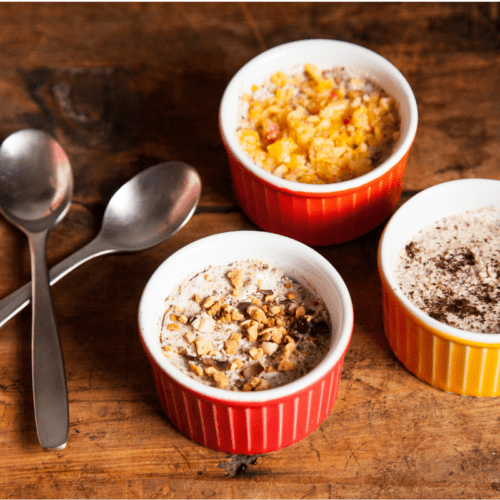
Low Histamine Baruka Nut Vanilla Mousse Recipe
Ingredients
- ¾ cups Baruka Nuts
- 1½ Tablespoons Coconut Oil melted
- ⅛ teaspoon Redmond Real Salt
- 1 (13½ ounce) can Coconut Cream solids
- ¼ teaspoon Raw Vanilla Powder
- 10 drops Stevia
- ⅛ teaspoon Smart Monk 100% Pure Monk Fruit Powder
Garnishing (optional)
- ⅛ cup Baruka Nuts
- ¼ teaspoon Raw Vanilla Powder
- 1 (13½ ounce) can Coconut Cream solids, whipped
- 10 drops Stevia
Instructions
- Necessary pre-step: refrigerate coconut cream for at least 8 hours to make it easier to whip. It’s much easier than using it at room temperature.
- Place baruka nuts in a high-speed blender (like a Vitamix or Blendtec) or a food processor. Pulse until nuts start to clump together like nut butter.
- Pour the melted coconut oil in and process 30-40 seconds to mix. It will be very thick but should have a spreadable consistency. Baruka nut butter needs to be completely smooth for the best texture for the mousse.
- Note: When adding coconut cream, you’ll notice the solids and liquids have separated in the can. Use the solids and discard the liquid portion. (If you get some liquid in it won’t be a problem.)
- In a large bowl, add coconut cream solids only (not liquids which have separated), stevia, monk fruit, salt, and vanilla powder.
- Use an electric mixer and beat the coconut mixture on medium speed until thick and fluffy. Beat until you get stiff peaks. That means if you pull your beaters up out of the coconut mixture, the coconut cream will have a tip that stands up on its own.
- Fold baruka nut butter gently into whipped coconut cream. Then, beat if needed for about 10 seconds to fully combine.
- I used a scoop that measured ¼ cup to evenly distribute the coconut mixture into ramekins. You can use any spoon, though.
- When you serve it right away, you’ll enjoy a light, airy mousse. But you can chill it in the refrigerator and serve later. It will be denser, but it’s still a tasty treat.
Optional Topping
- Whip the can of coconut cream and stevia together using an electric mixer until you get a thick, fluffy whipped cream. Like you did with the mousse, separate the coconut cream liquids from the solids and just whip up the solids of the coconut cream.
- Then you can top your baruka nut vanilla mousse with whipped cream and sprinkle crushed baruka nuts and a pinch of vanilla powder on top for a pretty garnish.
Notes
Nutrition
What’s your favorite topping on coconut vanilla mousse? Share in the comments below!
More Low Histamine Desserts
Looking for more low histamine dessert recipes? Check these out:
- Low FODMAP Ice Cream – Low Lectin & Low Oxalate
- Pecan Clusters – Low Lectin & Medium Oxalate
- Apple Pie – Low Lectin, with Medium Oxalate and Low Salicylate Options
References
FoodData Central. (n.d.). Retrieved October 5, 2022, from https://fdc.nal.usda.gov/fdc-app.html#/food-details/1063993/nutrients
Hafezi, S. A., & Abdel-Rahman, W. M. (2019). The Endocrine Disruptor Bisphenol A (BPA) Exerts a Wide Range of Effects in Carcinogenesis and Response to Therapy. Current Molecular Pharmacology, 12(3), 230–238. https://doi.org/10.2174/1874467212666190306164507
Lan, X. B., et al. (2019). Neuroprotective effect of Vanillin on hypoxic-ischemic brain damage in neonatal rats. Biomedicine & pharmacotherapy = Biomedecine & pharmacotherapie, 118, 109196. https://doi.org/10.1016/j.biopha.2019.109196
Tai, A., Sawano, T., Yazama, F., & Ito, H. (2011). Evaluation of antioxidant activity of vanillin by using multiple antioxidant assays. Biochimica et biophysica acta, 1810(2), 170–177. https://doi.org/10.1016/j.bbagen.2010.11.004
Vanilla extract nutrition facts and analysis. (n.d.). https://www.nutritionvalue.org/Vanilla_extract_nutritional_value.html
Zhao, D., Jiang, Y., Sun, J., Li, H., Huang, M., Sun, X., & Zhao, M. (2019). Elucidation of The Anti-Inflammatory Effect of Vanillin In Lps-Activated THP-1 Cells. Journal of food science, 84(7), 1920–1928. https://doi.org/10.1111/1750-3841.14693

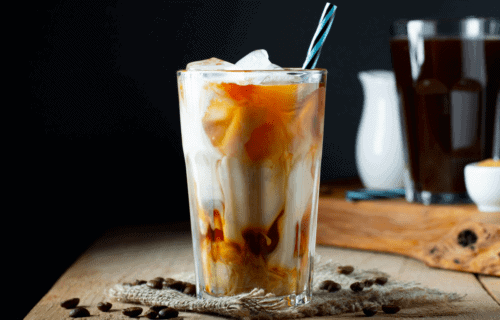
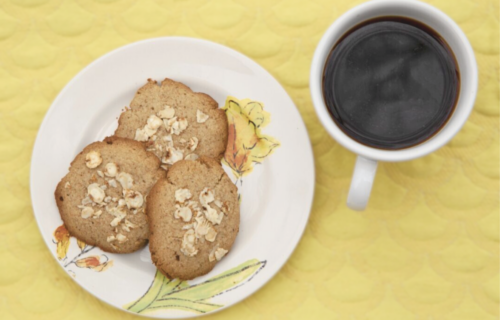
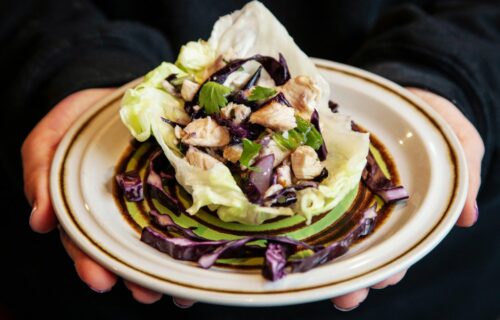
I would really like to try this recipe but I’m uncertain about eating vanilla on a low histamine diet. As far as I can tell, all vanilla beans are cured, which includes fermentation, which means histamine.
Is it tolerated by some people (despite moderate histamine levels?) if used in the small amounts called for by most recipes? It’s not mentioned in the high- or low-histamine food lists: what phase in the low histamine diet should I try vanilla powder?
Hi Lauren, vanilla extract is higher histamine because of the alcohol, and you are correct vanilla pods, powder, etc will be produced with fermentation which means histamine but are generally tolerated in small quantities. When you choose to add vanilla will depend on your personal sensitivity level, but typically this would be something you might want to wait until Phase 2 after your histamine intolerance symptoms have greatly improved. Hope that helps!